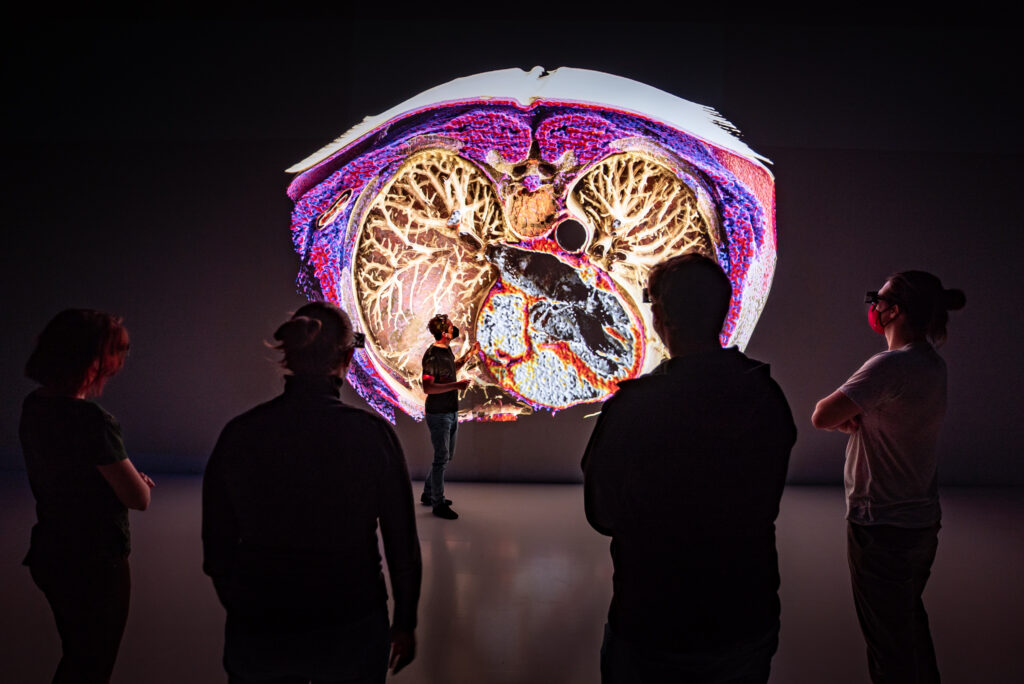- More information about the project
- More about Ars Electronica Futurelab, Siemens Healthineers & Johannes Kepler University Linz
- Images via Flickr
- Youtube Video
- Press Release as PDF
(Linz, November 7, 2023) The human body in 3D and 8K, larger than life and displayable down to the smallest detail: The globally unique application Cinematic Virtual Anatomy by Ars Electronica Futurelab, Siemens Healthineers, and Johannes Kepler University Linz has now received the “Business Model Innovation” jury prize at the Upper Austrian State Prize for Innovation.
Cinematic Virtual Anatomy enables teaching anatomy in a completely new way, worldwide unique in this form: in stereoscopic 3D projection and 4K to 8K resolution on a projection surface of up to 16×9 meters. Teachers and students are immersed in larger-than-life, photorealistic 3D images of data from real patients, impressively clear from all angles and seamlessly zoomable. Organs and blood vessels, muscles and bones, as well as tumors and injuries can thus be viewed as three-dimensional objects in impressive clarity and magnified down to specific details using 3D glasses.
3D X-ray and CT images as learning tools
The program is based on an idea by Prof. Franz Fellner (Chair of Virtual Morphology at JKU Linz), who has been teaching virtual anatomy since 2021 with the help of Cinematic Virtual Anatomy in the JKU medSPACE at the JKU Linz Medical Faculty. The implementation of the JKU medSPACE and the adaptation of the software to stereoscopic 3D in such high resolution come from the Ars Electronica Futurelab. Ars Electronica’s artistic research and development lab had already set standards with the development and construction of Deep Space, the unique 3D experience space in the Ars Electronica Center. Cinematic Virtual Anatomy is based on the Cinematic Rendering program by Dr. Klaus Engel from Siemens Healthineers, which has already been in use for many years for three-dimensionally displaying X-ray and CT images in hospitals.
From the hospital straight into the lecture hall of the future
The data presented in Cinematic Virtual Anatomy comes from real patients. The data can be transferred fully anonymized from the hospital to the lecture hall of the future within minutes, where it can be used directly in a lecture and saved for later presentations. Students thus learn using real data instead of abstract models and gain a better insight into the interrelationships of the human body. In contrast to conventional anatomy, the data from Cinematic Virtual Anatomy is available at any time and is easily reproducible. In addition, irreparable mistakes in dissecting bodies are impossible here, because the digital changes in the virtual anatomy can be reversed as often as desired and certain anatomical structures can be shown and hidden in a controlled manner.
Successful learning and motivation confirmed
The success of the new lectures with Cinematic Virtual Anatomy in the JKU medSPACE proves the concept right – the increase in knowledge of the students through the new lecture is clearly measurable. Moreover, the future physicians are enthusiastic: They praise the lecture as their “absolute favorite course in the preclinical phase”, which brings the understanding of the complex structures in the body into a “whole new dimension”, according to the JKU students in a survey by Univ.-Prof. Fellner. In short: “A highlight!”




